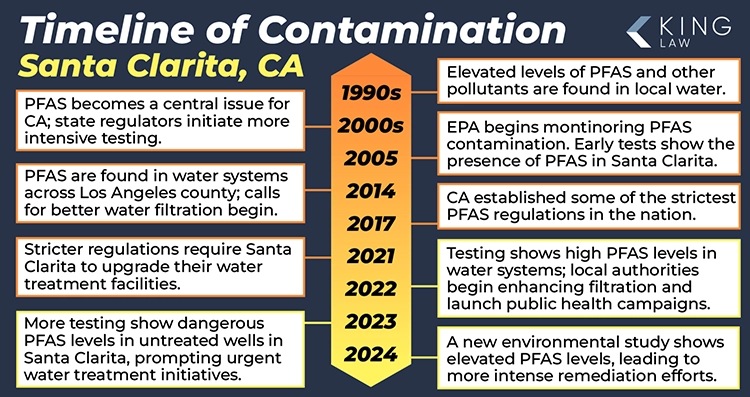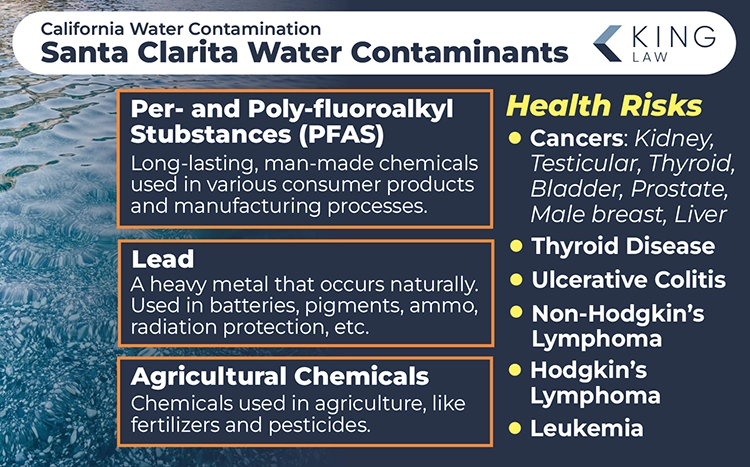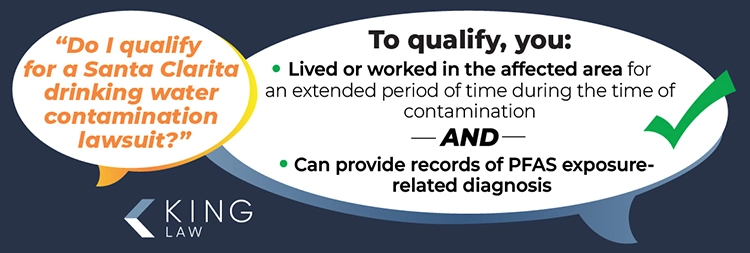
Residents of Santa Clarita, California, are filing water contamination lawsuits due to exposure to Per- and Polyfluoroalkyl Substances (PFAS), also known as “forever chemicals.” These chemicals have been linked to serious health risks, including kidney cancer, liver cancer, testicular cancer, thyroid disease, and ulcerative colitis. The lawsuits aim to hold manufacturers and industries accountable for contaminating the local water supply with PFAS, which persist in the environment and accumulate in the human body over time. As more cases of health impacts emerge, additional lawsuits are being filed. Santa Clarita residents seek justice and compensation for the harm caused.
Santa Clarita Water Contamination Lawsuit Overview
Santa Clarita, a vibrant city known for its scenic views and growing population, has faced increasing environmental concerns, particularly regarding water quality. In recent years, elevated levels of PFAS have been detected in local water sources. These chemicals, widely used in industrial applications, have raised significant concerns due to their link to life-threatening health conditions such as kidney cancer, thyroid disorders and liver damage.
As news of PFAS contamination in Santa Clarita spread, many residents became alarmed by the potential long-term effects. Lawsuits have been initiated by individuals and families seeking compensation for health issues linked to PFAS exposure. Legal experts, including King Law, support affected individuals, guide them through the legal process, and advocate for their rights to clean water.
Santa Clarita Water Contamination Lawsuit Updates
- Early 2000s: Initial concerns about Santa Clarita’s water quality emerged when studies detected low levels of various contaminants, including agricultural runoff.
- 2005: The EPA began monitoring PFAS contamination, and early tests in Santa Clarita showed the presence of these chemicals.
- 2014: PFAS were found in water systems across Los Angeles County, where Santa Clarita is located, leading to calls for better water filtration technologies.
- 2017: California introduced some of the nation’s strictest PFAS limits in drinking water due to rising contamination levels, sparking action in Santa Clarita.
- 2021: Stricter regulations required Santa Clarita to upgrade its water treatment facilities to meet new PFAS standards.
- January 2022: Testing revealed high PFAS levels in Santa Clarita’s water systems, prompting local authorities to enhance filtration efforts and launch public health campaigns.
- February 2023: Groundwater studies found dangerous levels of PFAS in untreated wells in Santa Clarita, leading to urgent water treatment initiatives.
- July 2024: A new environmental study uncovered elevated PFAS contamination levels in Santa Clarita, prompting intensified remediation efforts from local and state authorities.
Santa Clarita continues to confront these contamination challenges, with ongoing legal actions to hold responsible parties accountable.
About Santa Clarita, California Water Contamination:
History of Water Contamination in Santa Clarita, California
Sources of Water Contamination in Santa Clarita
Santa Clarita, California Water Contamination Map
Santa Clarita, California Drinking Water Contaminants
Current Water Quality in Santa Clarita, California
Health Risks Linked to Drinking Water in Santa Clarita
Eligibility Criteria for the Santa Clarita Water Contamination Lawsuit
Santa Clarita Water Contamination Settlement and Payout Amounts
How to File a Santa Clarita, California Water Contamination Lawsuit
Statute of Limitations for Santa Clarita Water Contamination Claims
History of Water Contamination in Santa Clarita
The history of water contamination in Santa Clarita is closely tied to industrial activities and firefighting foam usage at local facilities. Concerns first arose in the 1990s when studies showed elevated levels of PFAS and other pollutants in the water. The city’s close proximity to industrial zones and military installations contributed to the contamination, with agricultural runoff adding further pollutants.
By the early 2000s, PFAS contamination became a central issue, prompting state regulators to begin more rigorous testing. Despite California enacting some of the nation’s strictest PFAS regulations by 2021, Santa Clarita’s water systems struggled to meet compliance, highlighting the difficulty in addressing long-standing contamination issues.

Sources of Water Contamination in Santa Clarita
Several sources contributed to the water contamination in Santa Clarita. PFAS primarily entered the water supply from the use of firefighting foam at industrial facilities and military bases. These chemicals were also introduced through manufacturing processes and improper waste disposal practices. Additionally, agricultural runoff from surrounding farms added to the contamination, bringing pesticides and fertilizers into local water sources. Combined, these factors have led to a complex contamination crisis affecting thousands of residents.
Santa Clarita Water Contamination Map
The map provided highlights the areas in Santa Clarita most impacted by water contamination, with a particular emphasis on regions near industrial zones, residential neighborhoods, and areas adjacent to highways and commercial centers. It visualizes the spread of PFAS and other pollutants over time, demonstrating the environmental and public health consequences. Locations closer to contamination sources, such as factories and industrial plants, are especially at risk, with groundwater and drinking water supplies in these zones containing the highest levels of hazardous substances.
Contaminants Found in Santa Clarita Drinking Water
PFAS Contamination
PFAS, or per- and polyfluoroalkyl substances, have been detected in Santa Clarita’s water supply. These “forever chemicals” are highly resistant to degradation, allowing them to accumulate in the environment over time. PFAS primarily enter the water from firefighting foams, industrial activities, and chemical manufacturing. Exposure to these substances has been linked to serious health problems, including kidney and testicular cancers, thyroid disorders and developmental delays in children.
Lead
Lead has also been found in Santa Clarita’s drinking water, particularly in older neighborhoods with aging infrastructure. Lead seeps into the water through corroded pipes and plumbing systems, posing serious health risks to pregnant women and young children. Prolonged lead exposure can cause developmental delays, neurological impairments and chronic health issues.
Agricultural Chemicals
Chemicals from nearby agricultural activities, including pesticides and fertilizers, have also contributed to water contamination in Santa Clarita. Nitrates and other harmful substances have been detected in the water, raising concerns about reproductive health issues and the potential for increased cancer risks.

Current Water Quality in Santa Clarita
Santa Clarita’s current water quality is a significant concern as several contaminants continue to exceed EPA guidelines. Elevated levels of PFAS, along with traces of lead and agricultural runoff, present ongoing public health risks. While the city is taking steps to monitor and reduce these contaminants, the scale and persistence of the pollution pose considerable challenges to ensuring safe drinking water for all residents.
Water Treatment Efforts at Santa Clarita
Water quality in Santa Clarita remains a concern as several contaminants exceed EPA safety standards. Elevated levels of PFAS, along with traces of lead and agricultural chemicals, continue to threaten public health. The city is actively monitoring and working to address these pollutants, but the scale and persistence of the contamination present ongoing challenges in ensuring safe drinking water for residents.
Health Risks and Symptoms Linked to Santa Clarita Water Contamination
Long-term exposure to contaminants in Santa Clarita’s water supply, particularly PFAS, as well as from nearby military facilities such as the Edwards Air Force Base, has been associated with a range of serious health issues. Edwards Air Force Base has contributed significantly to PFAS contamination due to the use of firefighting foams and other industrial activities, which have leached into the surrounding groundwater. Research indicates that PFAS exposure can heighten the risk of several cancers and other health problems. The persistence of these chemicals in both the environment and the human body amplifies these risks, making early detection and ongoing health monitoring essential for those affected.
PFAS exposure has been linked to the following health conditions:
- Kidney cancer
- Testicular cancer
- Thyroid cancer
- Thyroid disease
- Ulcerative colitis
- Bladder cancer
- Non-Hodgkin’s lymphoma
- Hodgkin’s lymphoma
- Leukemia
- Male breast cancer
- Prostate cancer
- Liver cancer
Regular health check-ups and screenings are crucial for individuals who may have been exposed to contaminated water in Santa Clarita and the surrounding areas, including near Edwards Air Force Base. Local health departments provide screening programs aimed at monitoring conditions related to PFAS exposure. Early detection can be life-saving, as prompt treatment can improve outcomes for cancers and other illnesses linked to contamination. Affected residents are encouraged to remain proactive, participate in these health programs, and consult healthcare providers for ongoing monitoring.
Eligibility Criteria for the Santa Clarita Water Contamination Lawsuit
To qualify for the lawsuit, individuals must have lived or worked in Santa Clarita during the period of contamination and must provide medical records showing diagnosis of PFAS-related health conditions. Legal experts can help determine eligibility for compensation.

Santa Clarita Water Contamination Settlement and Payout Amounts
Settlement amounts in the Santa Clarita, California, water contamination lawsuits will vary based on several factors, including the level of exposure, the length of time residents lived in affected areas, and the severity of health issues experienced. Drawing from similar cases, settlements could range from $30,000 to $300,000, with potentially larger sums for individuals facing serious health complications related to PFAS exposure.
How to File a Santa Clarita Water Contamination Lawsuit
Filing a water contamination lawsuit in Santa Clarita requires gathering essential evidence, including medical records and documentation proving residency during the contamination period. Affected individuals should consult experienced environmental attorneys to navigate the legal process and assess their claims.
- Consultation with a Specialized Attorney:
The first step in initiating a lawsuit is to consult an attorney skilled in environmental law or toxic tort cases. Considering the historical context of the area, particularly nearby military installations like Edwards Air Force Base, your attorney will evaluate the merits of the case, identify responsible parties (such as industrial facilities or government entities), and develop legal strategies for claims related to contaminants like PFAS or lead.
- Pre-Filing Investigation and Documentation:
Before filing, it’s crucial to gather comprehensive evidence, including scientific studies confirming the presence of contaminants, environmental impact assessments, and health data linking exposure to negative health effects. Additional documentation might include regulatory reports from agencies like the California Water Boards or Department of Toxic Substances Control, as well as medical records showing illness caused by contamination. Engaging expert witnesses—such as toxicologists or hydrologists—can further strengthen your case.
- Filing the Complaint:
Once prepared, the attorney will draft and file a complaint with the Los Angeles County Superior Court, detailing the defendants (e.g., responsible industries or negligent parties) and legal claims such as negligence, property damage, and personal injury. The complaint must clearly explain how contaminants entered the water supply and their harmful effects on residents.
- Discovery and Expert Testimony:
After filing the complaint and serving the defendants, both parties enter the discovery phase, exchanging evidence and collecting additional documentation. In these cases, discovery may include access to extensive environmental data, historical pollution records, and depositions from scientific experts. Additional studies related to agricultural practices and military activities may also be required, given the area’s reliance on groundwater.
- Unique Legal Considerations:
Lawsuits in Santa Clarita may involve oversight from the California Environmental Protection Agency (CalEPA), and plaintiffs may need to meet specific reporting obligations. Statutes of limitations for environmental cases can vary and may be shorter or have exceptions based on when the contamination was discovered and the health effects observed.
Evidence to Support Your Claim
In water contamination cases in Santa Clarita, California, constructing a robust claim necessitates a blend of scientific, medical, and legal evidence to establish a connection between contaminants like PFAS, lead, or pesticides and health or property damage. Medical records are vital for illustrating the effects of exposure on health, demonstrating a direct link between contamination and illnesses such as cancer, developmental disorders, or other chronic conditions. Expert testimony from toxicologists, hydrologists, and environmental scientists plays a crucial role in identifying the sources of contaminants, their pathways through soil or groundwater, and the associated risks to the community. These experts can lend credibility to claims and clarify the scientific relationship between exposure and the resulting harm.
Additionally, environmental studies are key to supporting claims. Reports from organizations like the California Environmental Protection Agency (CalEPA) and the California Water Boards provide official data on contaminant levels, the spread of pollutants, and historical contamination evidence. Local water quality assessments and soil analysis reports can further reinforce your case by illustrating the extent and duration of contamination. Essential evidence typically includes:
- Medical records documenting illnesses linked to contamination (e.g., cancer, liver damage, developmental delays).
- Proof of residence indicating that you lived in the contaminated area during the relevant period.
- Water quality reports from local utilities or environmental agencies showing the presence of hazardous substances like PFAS or lead.
- Testimony from expert witnesses, including scientists or environmental health professionals.
- Assessments of property damage reflecting the impact of contamination on land or water resources.
- Scientific studies or environmental reports that connect local contamination to health risks.
Statute of Limitations for Santa Clarita Water Contamination Claims
The statute of limitations for filing a water contamination claim in Santa Clarita can vary, but it is generally advisable to act as soon as possible. Consulting a lawyer early in the process is critical to ensure compliance with the legal deadlines and to maximize the chances of a successful claim.
Santa Clarita Water Contamination Lawyers
King Law attorneys specialize in water contamination lawsuits in Santa Clarita, California, offering extensive expertise in environmental law, particularly related to PFAS and municipal water contamination cases. Their experienced legal team has successfully handled complex lawsuits involving toxic chemicals like PFAS, helping affected residents understand their legal rights and seek compensation. King Law’s attorneys are skilled at evaluating claims, gathering necessary documentation such as medical records and proof of contamination, and representing clients throughout the legal process to ensure that their cases are thoroughly prepared and pursued.
Choosing a qualified attorney is crucial for those impacted by Santa Clarita’s water contamination issues. King Law provides personalized legal guidance, helping individuals navigate the complexities of environmental litigation and offering critical support from the initial claim evaluation to court representation. Their experience in securing settlements and holding responsible parties accountable makes them a strong advocate for residents seeking justice and financial compensation for the health risks posed by PFAS exposure.
Frequently Asked Questions (FAQs)
Learn more about Santa Clarita, California water contamination with these frequently asked questions.

